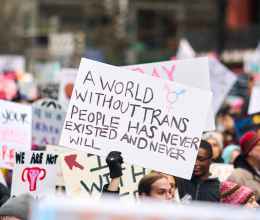
Media Reference Guide - In Focus: Covering the Transgender Community
UCLA's Williams Institute estimates there are 1.4 million transgender people in the United States. But according to a GLAAD/Harris Interactive poll, only 16% of Americans say they personally know someone who is transgender. A 2013 Pew poll shows that 87% of Americans say they personally know someone who is gay or lesbian. If a stereotypical or defamatory image of a gay or lesbian person appears in the media, viewers can compare it to real people they know. But when a stereotypical or defamatory image of a transgender person appears in the media, the viewer may assume that all transgender people are actually like that; they have no real-life experience with which to compare it.
Transgender issues can be complicated, but GLAAD staff are always available to answer questions, provide resources, and identify spokespeople. Below are some basic tips for writing fair and accurate stories about transgender people.
Basics of writing a transgender story
Language is important. Using accurate terminology is the first step toward creating a respectful story about transgender people. The Transgender Terminology section of this guide (pg 10) offers definitions of basic terms, along with guidelines on name and pronoun usage and a list of defamatory and offensive terms to avoid. More resources for journalists may be found at glaad.org/transgender.
Moving beyond the coming out narrative. People who have just come out publicly as transgender are considered newsworthy, but they are often not ready for media attention, nor are they ready to speak about larger issues facing a diverse transgender community. Consider interviewing people who have chosen to take leadership roles in the community. Furthermore, the "coming out" or "transition narrative" has been covered thoroughly since Christine Jorgensen came back from Europe in 1952. Just as coverage of the LGB community now focuses on many different aspects of being gay, lesbian, or bisexual, the media is encouraged to look for stories about transgender people that go beyond "when did you know" and "what surgeries have you had."
Avoid focusing on medical issues. It is inappropriate to ask a transgender person questions about their genitals or other surgeries they may or may not have had. Typically, those questions are only asked out of prurient curiosity. They also distract the journalist and the viewer from seeing the whole person, and from focusing on larger issues that affect transgender people like discrimination, poverty, and violence. Do not characterize being transgender as a mental disorder. Neither the American Psychiatric Association nor the American Psychological Association consider being transgender a "mental disorder."
Describing the fact that someone is transgender. Transgender should always be used as an adjective. For example, "Susan is a transgender woman." If your audience needs clarification about what that phrase means, you can explain that "Susan was designated male at birth, and began her transition 15 years ago." Avoid "Susan was born a man." People are born babies and a doctor decides the sex based on a quick look at the baby's external anatomy. A transgender person's gender is much more complicated than a simple glance at external anatomy can capture. A person's biology does not "trump" their gender identity, and oversimplifications like "born a man" can invalidate the current, authentic gender of the person you're speaking about.
Disclosing birth names. When a transgender person's birth name is used in a story, the implication is almost always that this is the person's "real name." But in fact, a transgender person's chosen name is their real name, whether or not they are able to obtain a court-ordered name change. Many people use names they have chosen for themselves, and the media does not mention their birth name when writing about them, (e.g., Lady Gaga, Demi Moore, Whoopi Goldberg). Transgender people should be accorded the same respect. When writing about a transgender person's chosen name, do not say "she wants to be called," "she calls herself," "she goes by Susan," or other phrases that cast doubt on a transgender person's identity. Do not reveal a transgender person's birth name without explicit permission from them. If the person is not able to answer questions about their birth name, err on the side of caution and do not reveal it.
Illustrating your story and headlines. In almost every instance it is unnecessary to show before and after pictures of the person being profiled. Often these images are simply included to satisfy the invasive curiosity of readers or viewers, and in most cases, they add nothing substantive to the story. Similarly, avoid clichéd images of transgender women putting on make-up, wigs, or panty hose, and shots of transgender men shaving. These type of photos connote that being transgender is simply a superficial, external matter. Being transgender is not about or limited to physical appearance. With headlines, it is often necessary to save space and simplify; however not at the expense of resorting to clichés and offensive language. It is easy to ruin a well-written, nuanced story with a sensationalistic headline. Avoid phrases like "sex change" or "born a man" in headlines.
Bringing in expert opinion. Be cautious of inviting non-transgender guests to talk about transgender people – instead of talking to transgender people. Transgender people are the experts to talk about transgender people. You don't always need a medical or psychological "expert" to speak about transgender people, but if you'd like a medical or psychological perspective, there are many transgender doctors and psychologists who can speak with experience and authority.
Integrating transgender people into non-trans stories. While it is true that there are many social issues that must be addressed before transgender people are treated equally, it is also true that transgender people live day-to-day lives just like everyone else. When being transgender is just one of the many traits that make someone unique, we will move closer to full acceptance. If you are doing a story about women in tech or Mother's Day, consider including a transgender woman in those stories. Transgender people can also be booked to talk about issues that are not trans-specific.
Social issues facing transgender people
Transgender people, particularly transgender women of color, are disproportionately affected by hate violence. In 2015, 67% of LGBTQ homicide victims were transgender women, according to the National Coalition of Anti-Violence Programs. The majority were transgender women of color. For information on covering stories where a transgender person has been the victim of hate violence, please see the In Focus section on Hate Crimes and GLAAD's report "Doubly Victimized: Reporting on Transgender Victims of Crime."
Transgender people face high levels of discrimination and poverty. According to the largest national survey of transgender people, the community experiences unemployment at twice the rate of the general population, with rates for people of color up to four times the national unemployment rate. Transgender people are also four times more likely to live in poverty. Ninety percent of trans people report experiencing harassment, mistreatment, or discrimination on the job. Forty-one percent of transgender respondents reported attempting suicide, compared to 1.6% of the general population. More statistics from this survey may be found here.
Access to healthcare is extremely limited for transgender people. The American Medical Association has stated that treatment for gender dysphoria is medically necessary and involves changing the body to align with a person's gender identity (their internal sense of being a man or a woman.) Trying to change a person's gender identity is no more successful than trying to change a person's sexual orientation - it just does not work. However until very ecently, private insurance companies have treated transition-related medical care as if it is cosmetic - regularly inserting "transgender exclusion clauses" into health insurance plans making access to care difficult, if not impossible, for most transgender people. In 2016, the Department of Health and Human Services issued a rule stating that under the Affordable Care Act of 2010, individuals are protected from discrimination based on gender identity and sex stereotyping in health care settings that have a connection to federal funds, which includes the vast majority of health insurance companies. This is a huge step forward in improving access to healthcare for the transgender community. However, not all procedures associated with medical transition are covered by this ruling and any policy which does not receive federal funds may still discriminate. Furthermore, even if a transgender person has a health insurance policy which will cover medical transition, it can still be quite difficult to find any health care providers who are knowledgeable about transgender healthcare.
Covering nondiscrimination bills. When covering the Equality Act or other nondiscrimination bills that include gender identity, do not accept at face value misperceptions promulgated by anti-LGBTQ activists that nondiscrimination can be reduced to arguments about transgender people using the bathroom consistent with their gender identity. Nondiscrimination bills that are inclusive of gender identity and expression provide important protections for transgender people in housing, employment, and public accommodations. Transgender women are often the targets of violence and harassment when they try to use a public restroom consistent with the gender they live every day.
Full article and more, here: https://www.glaad.org/reference/covering-trans-community

